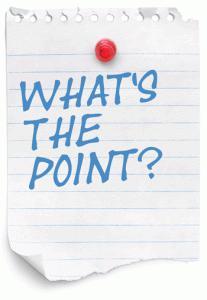
Why bother writing Learning Objectives?
Why go to the bother of writing learning objectives for your training program?
Our business sees many programs that simply wear participants out by being nine miles long and one inch thick with little opportunity to engage learners and practice skills and in the end serving no useful purpose for the organization paying for the program. These programs have a heavy emphasis on what needs to be taught with little regard to what participants will need to be able to do when they get back to their job – says Vicki Heath of Business Performance Pty, Ltd.
She has got a point and I’ll go one further, What is the point of writing learning objectives that are not even read by Human Resources managers?
This especially due to the sometimes, ‘one-size-fits-all” policy of many of the larger training institutions.
For learning or training objectives to be effective the onus needs to be shared and owned by the respective parties – a three-way contract that is facilitated by training professionals but not dominated by them.
Effective HR and L & D managers will tell you what they want, but may not know how to get it.
Learners and their managers have already informed HR & L & D departments of what they need – although there could be more of an accent on what they want, rather on what they really need.
So the process starts – the training professional then sets up the training course and the objectives from this, where their sole point of reference thus far has been the HR / L & D departments – a lopsided way to approach things in my mind.
If they are really lucky they may get access to the heads of departments (HODs) but that is sometimes quite rare.
So I ask the question, again, “Why bother writing Learning Objectives?”
The real point here is, “How to write effective Learning objective”
Let’s first look at the point of learning objectives:
1. They help channel learning to a clear goal with a qualitative or quantitative evaluation process that measure behavioural change, skill improvement and cognitive development.
2. They help a training professional to tailor learning to the cultural aspects of the learners – including corporate culture elements that could affect the learning program.
3. They help learning professionals align their programs to business goals.
4. There is a clear plan that both learners and facilitators are able to follow logically.
5. Contingency planning can be set-up alongside follow-up training / evaluation.
The process of objective setting should be a shared process, as I mentioned earlier – the role of a training professional is to guide, advise, channel and propose solutions from what is presented by the organisation.
The process follows the following steps:
1. Mine the needs from the HR / Management – what are the clear business needs – in terms of what should learners be expected to achieve after the training.
2. Assess the corporate culture – what is the attitude / culture to learning and people development and what are the potential barriers to overcome.
3. Evaluate the current level of skills and competences in the organisation – analyse the gaps between the current state-of-play and the desired outcomes.
4. Understand the forms of delivery that are available and which are best suited to the organisation / the learners.
5. Clarify who exactly is the client – CEO / HRD / Department heads etc.
6. Set-up joint meetings with the client and learners to discuss the objectives of training and the roles of learner / facilitator / trainer.
7. Decide on how learning is going to be assessed / evaluated and by whom – the trainer / the HR department or the learner’s manager.
8. Translate organisational goals to learning objectives with the learners down to specifics – use verbs and infinitives in the first person – “…. to communicate effectively with clients in a meeting setting to present our products with ease and confidence” etc. Ensure that the scenario gives weight to the context and is not left vague … i.e. Who / Where / When / Why / What
9. Set up - the contract is then set up and counter-signed by the client and learners – this is the engagement step – any last minute adjustments can be made at this point.
10. The Conclusion – of the training usually culminates in a report or evaluation of the training using the indicators used for the setting of the objectives, by the learners and presented back to the client by both trainers and learners.
In short, there is no way that a training program can be effectively ran without learning objectives being clearly established, shared, owned and agreed upon by the three parties involved in the training : Client / Learner / Trainer – anything less is the blind leading the blind into a coalmine in the dead of winter.
On the other hand – training objectives written solely by the trainer – is much like the blind leading the blind into a coalmine in the dead of winter with thick metallic gloves on … they may look good, but they are of no use at all to the wearer …

